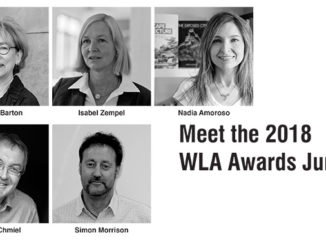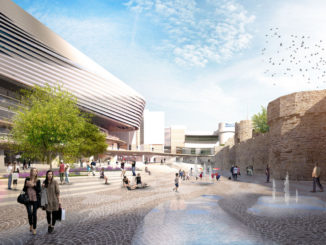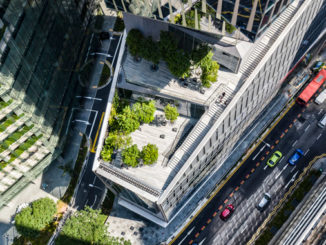WLA recently caught up with Peter Chmiel, Director of Grant Associates to ask him a few questions. Peter has over 30 years’ experience in landscape architecture his particular interest is the promotion of design quality and technical innovation through the synergy of landscape, architecture, nature, community, and place.
WLA | Who is Peter Chmiel?
Peter | For the last 20 years I have worked as a landscape architect and Director at Grant Associates, a landscape architecture firm established in 1997 and a leader in creative ecology, environmental sustainability and innovative landscape design. Having now reached my 55th year I must have accumulated over 30 years’ experience in landscape architecture. During this period my key driver and motivation has been the promotion of design quality and technical innovation through the synergy of landscape, architecture, nature, community and place.
My deep interest in connectivity with the natural environment has always influenced my direction in life, including my choice of career, home in the rural setting of Salisbury Plain and my field hobbies fishing and archery. Growing up on the edge of the Dartmoor certainly fuelled my passion for the natural world. Indeed, my first job was as an architectural technician working in a converted barn within Dartmoor National Park. This early experience of architecture and the love for the environment provided the conduit that directed me to focus my energy into landscape design. I graduated from university in 1987 and after a brief time at Atkin Sheppard Fiddler in Epsom I joined Ed Griffiths Partnership in Warminster Wiltshire. I then spent the next 10 years working on several large scale business parks and headquarter buildings that help develop early thoughts on sustainable landscape design, projects such as Stockley Park and the initial stage of the Millennium Dome. In 1997 I was invited by Andrew Grant to join him and Keith French to work on one of the UK millennium landmark projects The Earth Centre. The last 20 years have been amazing experience and we have now collectively worked on over 500 projects.
WLA | What do like about being a landscape architect?
Peter | Working in an international practice certainly provides exciting and diverse opportunities in respect of design challenges, professional collaboration, working cultures and site locations. Even after 30 years in the profession one always seems to either learn or experience something new on every project. That said, a very rewarding aspect of my job is seeing a completed project and returning in the future to see how it has hopefully improved the environment and influenced people’s perceptions on value of place.
WLA | Working as a landscape architect in different places and cities: what is one element or idea that you feel applies to all cities?
Peter | The creation of excellent live and work environments through the integration of landscape to benefit of the city economy whilst providing a sense nature in everyday life.
It’s great and exciting that there is clear shift towards blue and green infrastructure within our cities. Technological advances in detailing, materials and the way we work are certainly helping to facilitate smart landscape responses in city locations that simply would not have been achievable a decade ago. However, there should also be an equal emphasis on creating memorable and inspiring landscape experiences that respond to individual city identities and cultures. The challenge is to avoid an ‘’ international design’’ language where sense of place and identity might become compromised. Ideally ever city should look to offer a landscape retreat, somewhere that provides close contact with nature and the elements.
WLA | How do think landscape architecture will change in the future?
Peter | Landscape architecture will continue in its creative design role and will increasingly deliver schemes that captured public attention and highlights big on environmental concerns and challenges. Future design projects will be increasing underpinned by scientific and environmental research. However, the key driver for the future of landscape architecture is we must perform and focus our skills on the scale which the planet and all humanity require the most – the macro scale. ‘’ The future is unknowable, but the past should give us hope’’ Winston Churchill.
The landscape architects role as part of the large scale urban decision making processes has continued to grow and evolve over the last 30 years. It has moved on from a consultation role dealing with smaller scale components that form part of the bigger picture such as ‘’ landscaping’’ pockets of space to, a key strategic role. Our design and strategic planning expertise is now acknowledge at a city and region- wide scale.
The challenges of climate change and the ever increasing demands put on the planet indicate we have an ever increasing role to play out. Looking to the past provides hope and inspiration in the theme of ‘’resilient nature’’ and its ability to bounce back. Past experiences help us understand the complexity and holistic nature of planet earth ecosystems and show us where and why it’s gone wrong. The big challenge for the future is to redesign our future cities aligned to their bioregional landscapes. Design narratives will increasingly be underpinned by robust green infrastructure strategies that facilitate adaption for climate change whist mitigating or, eradicating some of its main causes.
It is great that so many design disciples now talk enthusiastically about environmental systems, sustainable design and the added value of landscape in future cities. However, it takes a special combined skill set to champion city wide environmental design strategies. I believe few design discipline are better placed to both talk about, draw and orchestrate many of the design strategies needed to shape our future cities and help the heal the planet. There is an increasing number of landmark international projects where the design team leader has been a landscape focused practice. A trend which I believe will continue. Landscape architects are well positioned to unite multi-disciplinary teams, to forge competing interests together so they can address challenging social and ecological problems through a united and holistic design approach.
Our role in the shaping of future cities and our influence on the integration of alternative transport, nature in cities, urban foods and adaptation to climate change will all continue to grow.
I hope one of continuing trends within landscape architecture will be the renewed passion for planting design combined with science based research. It’s a simple but important message that increasing the opportunities for urban vegetation and inviting nature into our cities is massively important. While there is a huge role for smart green infrastructure such as green architecture and the like we must not lose sight of the need for simple large scale landscape interventions within our future cities. Strategies such as the Expansive Urban Forest will help create a more sustainable world and one where landscape is seen to provide an environmental, economic and even spiritual asset.
Thanks to Peter for taking the time to answer WLA’s questions



